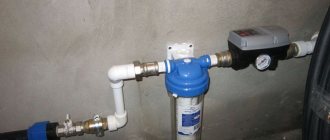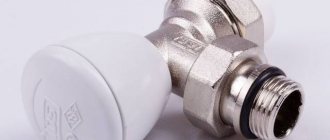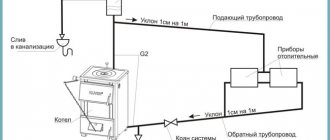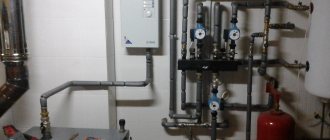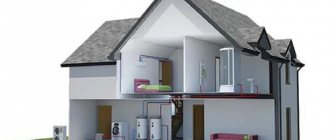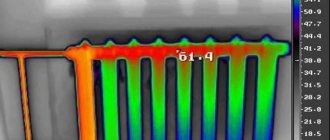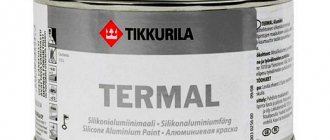Functions of mud collectors
When operating heating, water supply and other similar lines, one of the most pressing problems is the clogging of various areas with insoluble impurities of organic and inorganic origin - in other words, dirt. In open systems in which water is drawn from an external source, sand, clay particles, silt, etc. most often act as pollutants. In closed pollution systems, rust flakes, scale, separated scale fragments, and mineral deposits also occur. They all have one common property: most of these particles are heavier than the water or coolant circulating in the system.
A section of a pipe with pronounced silting. Accumulating in those places where the fluid flow slows down or changes direction, dirt over time significantly reduces the performance of the system - permeability, heat transfer, etc.; in some cases, serious blockages can lead to system failure. There is a need for mechanical or chemical cleaning (rinsing) of clogged elements. In order to reduce the concentration of dirt particles in the liquid, reduce the rate of blockage formation, and thereby reduce the frequency of complex and expensive cleaning or repair procedures, various filters are used. In particular - the so-called coarse filters, which include mud filters. Sometimes they are called mud collectors, as well as clarifiers: with an effectively functioning mud collector, at the outlet of it, the pumped liquid is even visually much cleaner and lighter than at the inlet.
Advantages and disadvantages
Debris from the mud trap gets into the boiler elements and interferes with normal operation.
The advantage of filters is to prevent contamination of the main components in the heating equipment. The presence of a mud trap in the system increases the service life of the coolant. In addition, among the advantages of the device are:
- fuel economy;
- reducing the cost of reagents for water purification;
- protection of convective elements of boilers.
The disadvantage of the mechanical principle of water purification is manifested in the rapid clogging of mesh filters with a high level of contamination of the working fluid. To solve the problem, a complex filtration technique is used. It consists of using magnetic mud scrapers to remove scale and rust, as well as a device with a mesh to remove suspended particles.
Types of filters for heating systems
The most extensive classification is the identification of two categories:
- Coarse filters, mud collectors, use a mesh to collect solid inclusions whose diameter exceeds 300 microns.
- Fine cleaning models are capable of retaining suspended matter in the range of 5-300 microns.
The latter are very rarely used in heating communications; they are more suitable for food and household needs. Therefore, it is advisable to consider 4 types of mud collectors common in the private sector.
Brass mesh oblique devices
They are optimal for local heating schemes and have a simple design. The products are equipped with threaded coupling connections, available in a variable range of sizes, which expands the possibilities of their use.
The monolithic cast brass body consists of a combination of two cylinders - horizontal and located at an angle to it. Both ends are equipped with threaded mounting couplings. At the end of the oblique cylinder there is a brass hexagonal plug sealed with a Teflon gasket. A steel mesh is located in the slope area. Before such a modification, a shut-off valve is installed to facilitate maintenance work and flushing.
To clean it, you need to turn off the coolant supply, place a container to collect liquid and dirt, unscrew the plug with a wrench and remove the mesh. The latter is treated with a polymer brush under strong pressure of water.
Cast iron oblique magnetic models
Their design is similar to the previous variation, the differences lie in the material - the plug and body are made of cast iron. The filter mesh is the same steel, it is used with a paronite gasket.
The filtration unit is complemented by a stand on which disk-shaped magnets are installed at a given interval; they are not subject to corrosion. Thanks to this rigid inclusion, two-way filtration is ensured: mechanical impurities remain in the mesh, scale and metal particles are captured by the magnetic block. High quality of coolant processing is ensured.
The installation and maintenance procedure is fully consistent with brass variations with one addition - magnetic disks also need to be washed.
Flange magnetic filters for heating systems
The modification is in many ways similar to the previous version, but it is larger in size and is designed to service larger diameter pipelines. The threaded plug in this case is replaced by a flange plug; sometimes a clogged drain hole is provided here, allowing liquid and dirt to be drained without dismantling the entire plug.
When selecting and installing such products, it is necessary to take into account the installation and operational parameters of length and height, and also provide a place for removing the plug, removing the magnetic block, mesh
Subscriber mud traps
They can be horizontal or vertical, the latter being more common. The devices have an impressive service life and are easy to use. Thanks to the large internal volume, the frequency of preventive maintenance is significantly reduced.
The cylindrical body is made of steel pipe. There are nozzles with a flange on both sides. The passing coolant undergoes two stages of purification: small suspensions are retained by the mesh, before large particles are deposited under the influence of centrifugal and gravitational forces. Reliable and simple design, affordable cost contribute to the widespread use of subscriber filters in autonomous heating systems.
On the specialized market there are self-cleaning mud collectors, supplemented with an air vent - dissolved gases are separated and removed in them.
Types of filters
Types of filters that are installed in the heating system
Classification of mud collectors for coolants is carried out according to 3 criteria:
- type of filtration of foreign fractions;
- type of service;
- installation method.
By type of particle separation
In a mesh filter for heating and heating private houses, dirt is captured by the mesh and remains in the accumulation zone. To clean the structure, the bottom of the glass is turned away and all technical debris is removed.
Heating filter with magnetic cleaning mechanism helps eliminate metal particles
They do not reduce the fluid flow rate, which is important when operating powerful pumps
By type of service
Internal structure of a flush-type mud basin
Depending on the classification by type of service, filters are divided into 3 types:
- Self-cleaning. Sediment from the glass and the top of the mesh is removed with water.
- Non-flushing. When cleaning them, the coolant unit requires complete dismantling.
- Flushing. The glass requires manual cleaning.
By installation type
Depending on the installation features, mud filters for heating systems are divided into 3 types.
Mud collectors with a coupling type of connection - couplings with internal threads are located on both sides of the device. The body of the device has hexagons for inserting an adjustable, open-end and gas wrench.
Filters with a flange connection include an additional bolted sealing ring.
Devices with a polypropylene pipe circuit are used for small diameter pipes.
Features of the use of mud collectors
All mud filters for heating systems can also be divided into those intended for vertical or horizontal installation. Vertical structures are more often used in large heating systems. It should also be remembered that vertically installed mud traps need to be serviced more often. The choice of size and cleaning parameters is made based on the diameters of the pipelines, pump power and installation locations.
Dirt trap with drain cock.
During installation, there are several rules that must be followed.
- Arrow on the body. As a rule, the filter has an arrow indicating the direction of movement of the coolant.
- The best location is a horizontal section of the pipeline.
- Spatial orientation. The branch with the mesh and nut or drain valve should face down.
- The presence of shut-off valves before and after the mud filter for water, as well as a pressure reducer after it.
- Ease of maintenance.
Strainers DN25, 1”.
Types of filters
There are several types of filter devices depending on the method of installing the mud trap on the heating system.
Kinds:
- Coupling units are used in circuits of small and medium cross-sections. They have a threaded coupling that makes them easy to install.
- Flange devices are suitable for large and medium diameter pipelines. During the installation process, a bolted fitting, an O-ring and mating flanges on the pipeline are used. The advantage of a flange filter is that it is easy to clean, because it can be removed without dismantling the pipes.
- Blind fixtures are welded to the pipeline. They have two pipes with allowances for the weld seam.
When choosing a filter device, you need to know in advance how to clean the sump in the heating system.
Based on the maintenance principle, there are three types of filters:
- Self-cleaning with a special tap. To remove toxins with a stream of water, simply open the valve.
- Flush with plug and stopper. To wash the device, you need to remove two devices.
- Non-rinsing filters are completely dismantled for cleaning. This is why they are not popular.
Depending on the principles of purification, mud filters come in fine and coarse filtration. Coarse filters have a mesh with a cell size of no more than 0.3 mm. They only retain large, dense contaminants. Fine cleaning devices with cells ranging from 5-300 microns are designed for purifying water in the water supply system. They are not suitable for heating networks due to rapid clogging.
Brass
Mesh units with a threaded coupling are installed in autonomous heating systems. Their sizes are in the range of 0.5-2 inches. The cell dimensions are 500-800 microns. The filters are designed for pressure in the region of 16-20 bar and pressure testing not higher than 24 bar.
Cast iron
Structurally, cast iron mud pans are similar to brass models. The difference is the presence of a magnetic stand. The unit has cast iron plugs and housing, as well as a stainless steel mesh. Cast iron filters trap mechanical particles and scale.
Flanged magnetic
This device has a flange plug, not a plug. A magnetic filter for heating has a mesh to retain mechanical particles, as well as a magnet to clean the coolant from scale. The dimensions of the device may vary, so when choosing it you need to take into account the network parameters.
Subscriber mud trucks
This model not only traps pollutants, but also serves as a sump. Subscriber mud collectors are installed vertically and horizontally. Since they are quite large in volume, they are rarely cleaned. These devices are mounted at any point in the network on highways of different cross-sections.
Self-cleaning mud pans
Self-cleaning devices are placed in a metal housing and have a coupling connection. They contain a glass made of plastic or steel to collect waste. There is also a faucet for flushing. Thanks to the outer mesh, air bubbles are removed from the coolant. The mesh inside is designed to remove mechanical pollutants.
There is a block at the top to collect filtered bubbles. It is equipped with an automatic air vent. To clean the filter, open the tap at the bottom and wait until the waste comes out along with the water flow.
The principle of operation of the mud collector
Pressurized water
, supplied from the city network, to the entrance to the heating point, or to another consumer, through the inlet pipe of the mud tank, enters its internal cavity.
As a result of this, the flow sharply
loses its speed of movement, as a result,
heavy
particles
settle
at the bottom.
Then under pressure
, water passes through
a mesh
filter installed on the outlet pipe.
The mesh filter is made of stainless
steel.
At this cleaning stage, are retained
.
Degree of purification
water, after passing is up to 90%.
Structurally, mud traps can be made
in several forms:
- horizontal,
- vertical
- and Y-shaped.
| Figure 1. Horizontal mud pan |
| Figure 2. Vertical mud pan. The filter element is visible in the section. |
Mudmen
, are installed at the entrances to heating points, both central and individual. Mud collectors can be operated at pressures of 2.4 – 6 MPa and temperatures up to 150C. Service life, with proper care, is 10 years.
The use of such a filter requires constant monitoring of the level of hydraulic resistance on the mud pan. If its indicator differs from the requirements of the technical documentation for the mud pan, then it is necessary to put it in for maintenance.
Mud hulls
can be equipped with removable bottoms and have side hatches, all this is necessary to provide access to the container where filtered debris accumulates.
In addition, mud collectors are equipped with devices for bleeding
air and water drainage.
By type of connection
, mud collectors are divided into
- flanged
- and welded.
Mud collectors refer to that type of pipeline
fittings, which may
not be registered
with the supervisory authorities of Russia.
During operation
mud collectors should use the requirements of the “Rules for the safe operation of steam and hot water pipelines.”
But in fact, the described models of mechanical filters - mud filters - are gradually becoming a thing of the past.
, they are being replaced by Y-shaped filters.
More compact
, with the ability to operate at higher pressure and temperature parameters Pn 160, T-550°C.
All this leads to their wider use. In these filters, in addition to the
a magnetic
is also installed to select
metal
inclusions from the water flow.
As an example of modern
Mechanical cleaning filters can be given - ARI-STRAINER mesh filter, in
a flanged
design, in a body cast from gray cast iron, for operation in an environment with a pressure of Pn16.
This filter is designed to clean
water or other liquids in the pipeline from
foreign
inclusions.
To expand the functions of the filter, meshes with smaller
hole diameters can be used.
| Figure 3. Y-filter |
Installation
To install the purifier into the system correctly, you need to take into account the main nuances and know the installation technology. Everything must be done in accordance with the requirements of GOST, according to which any device is fixed at a temperature of no lower than -20 degrees and a pressure of no more than 2.5 MPa. The installation of a water filter is carried out mainly on the return pipe in front of the circulation pump or boiler, if the pump is already part of it. This will allow you to remove various types of contaminants from the coolant during a circular motion along the contour. Installation of the filter on the heating system is carried out using an adjustable wrench or welding.
The tap of the main riser is first closed, and the remaining liquid is poured into a previously prepared container. Since the work can be dirty, it is worth covering the flooring with thick rags, and in the drainage area with polyethylene. Water is drained as much as possible, and radiators and pipes are washed if necessary. If they are clogged before installation, you may not expect the coolant to operate efficiently. Based on the type of device, it is installed on the pipeline. To do this, use a key or welding, while making sure that the sludge compartment is located at the bottom: dirt and rust clots should settle down, which is impossible if the container is located at the top of the device. This rule applies to all types of mud collectors, regardless of the method of their attachment (vertical or horizontal).
If the system was flushed before connecting, it is necessary to remove residual rust from the surfaces of the fastening points so that it does not cause a leak in the connecting units. If you plan to carry out welding work after cutting a section of pipe, you need to choose a convenient tool for high-quality chamfering. When there is no experience with welding, it is better to entrust the installation to a specialist who will do the job efficiently and airtightly.
Cleaners for gas heating boiler
The most commonly used water filters for gas boilers are polyphosphate and ion exchange.
Don't miss: Brick for the stove: fireproof, fireclay, ceramic - what to choose
Polyphosphate
These filters for heating boilers are a convenient and affordable option. The design is simple: it is a plastic flask, the inside of which is filled with sodium salt. Thanks to its crystals, a protective film is formed on the internal surfaces of the heating boiler and boiler, preventing scale deposition.
Liquid entering from the water supply system first passes through a filter, the crystals of which purify it, after which the water enters the pipes and the boiler itself.
It is mounted in front of the boiler.
Ion exchange
The device operates on the basis of a special filler contained in the cartridge. A special hydrogen resin plays the role of a cleaner.
The ion exchanger converts heavy metal ions into safer and lighter compounds, that is, the chemical structure of the water itself changes. Dissolved gases are discharged through special openings.
Maintenance and cleaning features
Self-cleaning filters have a special tap at the bottom: to remove accumulated dirt from the device, just turn the lever. At the same time, the filter mesh is also cleaned by the flow of water.
Better flushing is ensured with the help of a bypass bypass equipped with a valve - it must be provided for at the stage of installing the filter. Here, servicing comes down to redirecting the coolant flow from the reverse side. In this case, you can successfully free the mesh cells even from densely embedded solid inclusions. The contaminants are then removed through the drain valve.
Flushing models are very convenient to use. In this section of the system, the liquid supply is turned off, the flange plug or plug is removed from the device, and the filter component is removed. After washing the latter, the device is assembled in the reverse order.
Finally, non-flush mud collectors require complete dismantling, so they are extremely rarely used in autonomous heating networks. Here the maintenance is based on the actual output of the device from the circuit.
Characteristics of mud collectors
| Sump | |||||||
| Designation | Т34.000.B | GDV 000 | GTR | GW | GW | GG | GG |
| Series | TS-569. | TS-567. | TS-568. | TS-565. | TS-566. | ||
| Type | Vert. | Vert. | Vert. | Vert. | Vert. | Horizon | Horizon |
| Diameter, mm | 40…200 | 40…1500 | 40…200 | 200…300 | 350…1000 | 150…400 | 500…1400 |
| Pressure, MPa | 16 | 1,0/1,6/1,25 | 1,6/1,25 | 1,6/1,25 | 1,0/1,6/1,25 | 1,0/1,6/1,25 | |
| Temp., max | 150 | 200 | 200 | 200 | 200 | 200 | 200 |
| Productivity, t/h | DN40-6DN50-10DN65-18DN80-26DN100-40DN125-58DN150-89DN200-158 | DN40-6DN50-10DN65-18DN80-26 DN100-40DN125-58DN150-89 DN200-158 | DN40-6DN50-10DN65-18DN80-26DN100-40DN125-58DN150-89DN200-158 | DN200-158 DN250-247.3 DN300-356 | DN350-484.6 DN400-633DN500-989DN600-1424DN700-1939DN800-2532DN900-3205DN1000-3957 | DN150-89 DN200-158 DN250-247.3 DN300-356 DN350-484.6 DN400-633 | DN500-989DN600-1424DN700-1939DN800-2532DN900-3205DN1000-3957DN1200-5697DN1400-7755 |
Reticulate
The mesh device is a housing with a mesh filter inside. The most popular option looks like a piece of pipe with a diagonal “spout” (bend), at the end of which there is a screw-off plug. Water, passing through the mesh, leaves suspended matter in it and then goes into the purified system.
From time to time you have to unscrew the plug and remove the filter mesh for washing. Then everything is put back in place, and the device itself does not need to be removed from the pipe. This is the so-called flushing threaded mud sump, but there are many more different types.
According to the type of self-cleaning, the mesh filter can be:
- non-flush - rinsing is carried out after removing the device and disassembling it;
- flushing - to clean, just unscrew the plug and remove the mesh;
- self-flushing - dirt is removed from the mesh by a water flow from the opening of a special drain valve.
Depending on the mounting method, coarse filters differ in:
- welded;
- threaded;
- flanged.
Most heating models have an additional mesh to separate air from the water flow. When it accumulates excessively at the top of the mud trap, the float is activated, and the needle valve allows the gas to exit the device.
The effectiveness of the mesh option directly depends on the smoothness of the increase in hydraulic resistance in the system, both before and after it. Constant changes in pressure in the pipes can cause dirt particles to be forced through the mesh.
You can track the degree of contamination of the mesh by constantly removing it and visually checking it. Or install pressure gauges on both sides of the sump tank and use their readings to monitor how dirty the filter is. There are also variations with a glass bulb for visual inspection.
Main types of filters and their design
Today, several designs of mud filters for heating systems have been developed. The principle of operation is similar for all - filtration of a coolant liquid, extraction of solid insoluble inclusions and their accumulation in a filter element or settling tank. Depending on the type of system, there are mud filters for industrial systems, and there are those that are used in individual heating installations, for example, in apartments or private houses.
Classification according to installation and cleaning method
Mud traps for heating systems are most often classified according to the method of installation in the system:
- On a threaded connection;
- Installed using flanges;
- Devices that require welding for installation;
New devices for plastic heating pipes are installed by soldering, so they can conditionally be classified as welded, although today they can be called a separate type of classification.
Classification according to the degree of purification divides filters into coarse filters and fine filters. The former are capable of capturing only large particles, but fine filters are capable of sifting out particles of several microns.
Classification by method of service
There is also a classification according to the method of maintenance, in other words, because the contents of the filter elements are cleaned:
- Self-cleaning;
- Flushing;
- Non-flush;
The former are cleaned by washing the mesh when opening the valve on the filter housing. All contents are simply discharged out through the valve. In washable filters, after removing the lid or flask, the filter element is removed and cleaned first with a brush and then washed with a stream of water. Non-flush ones require complete removal from the system and maintenance in workshops or replacement with a new mud collector.
For a specific heating system, it is also important how the coolant is cleaned. The simplest and most common are mesh filters.
In the body of the mud tank, the coolant passes through a stainless steel mesh and insoluble particles are retained on the metal. To clean the filter itself, rinsing is done by opening the valve on the body or removing the mesh from the filter bowl
The simplest and most common are mesh filters. In the body of the mud tank, the coolant passes through a stainless steel mesh and insoluble particles are retained on the metal. To clean the filter itself, washing is done by opening the valve on the body or removing the mesh from the filter bowl.
Strain filters are installed both in small installations and in industrial heating plants. The advantage of this type of device is its reliability and simplicity of design.
In addition to the usual mesh filter, mesh filters with self-cleaning and with the additional function of an air vent have recently begun to be used. In addition to the coarse filter, a separator filter made of a fine mesh network is installed in the housing, which ensures the separation of gas particles and removes them to the air vent. The operating efficiency of this type of device largely depends on the pressure in the line - the higher the pressure, the more effective the process of cleaning and degassing the coolant.
Magnetic filters are similar in design to mesh filters, the only difference being that magnets are installed around the mesh in the housing, which attract metal particles and rust.
Another type of device provides cleaning of the coolant using gravity. The filter housing is a large-diameter container in which pipes for inlet and outlet of coolant are installed at different heights. When entering a large-diameter settling filter, the liquid changes direction of movement, which results in the formation of numerous flows and turbulences. Heavy particles break off and settle to the bottom of the filter. Such installations are most often used in industrial boiler houses and heating plants.
Types and characteristics
Mud traps are made of durable steel and are designed as a pipeline expansion unit. Purification of the transported medium from impurities occurs under the influence of gravitational forces, changes in the direction and speed of flow. Sometimes it is possible to install a mesh to remove suspended particles.
According to their design, steel mud pans are:
- Vertical.
- Horizontal.
The diameter of the mud pan is selected taking into account the dimensions of the pipeline: it should be several times larger than the cross-section of the pipes. Fixation at the installation site is carried out using welding or flanges, which allow the cleaning devices to be repeatedly dismantled.
How to properly clean and what filters are best to buy for your home
It is recommended to choose mud collectors for heating systems in a private home, listening to the advice of a specialist. So for heating systems where the principle of natural coolant circulation with an expansion tank and metal heating pipes is used, it is more convenient and easier to install a circulation pump and a flanged sump. For modern double-circuit boilers, mud collectors for heating systems can be installed in either a plastic or metal casing. For large volumes of systems, for example, for the installation of a private two-story cottage, mud collectors for heating systems with air exhaust and self-cleaning functions are recommended. This is due to a large amount of coolant and a large number of points potentially prone to saturating the system with sludge and rust.
As for care and maintenance, here you need to remember two basic rules - first, maintenance is carried out after the end of the heating season and before the start, after a trial fire. The second rule requires constant monitoring of the operation of the system - if the pressure in the system increases and the batteries remain cold, you must first clean the mud traps and bleed the formed air in the radiators, then repeat the procedure after 2-3 days to finally normalize the operation of the system.
The cleaning process itself usually takes a few minutes - you need to turn off the boiler, turn off the water supply, open the lid and remove the filter for washing in a regular filter, or open the valve and clean the contents of the tank under pressure.
As you can see, mud collectors for heating systems play an important role for the proper operation of all its elements. Therefore, neglecting the installation of a mud trap for the heating system is extremely unprofessional.
Additional structural elements
The design of the mud pan may also contain other elements that simplify maintenance or increase its functionality:
- in addition to the mentioned drain valve at the bottom, there is an air valve at the top of the mud pan to de-air the system when filling it with liquid;
- at relatively low pressure levels in the system, a transparent window can be provided on the side surface of the cylinder to assess the degree of contamination;
- Pressure gauges can be installed on the inlet and outlet pipes, by the difference in readings of which one can estimate the hydraulic resistance of the mud tank and, as a consequence, the same degree of contamination.
Mud traps can be produced with a flange connection and a “weld” connection. The first option is considered preferable, as it allows the mud collector to be easily replaced if necessary. However, such a replacement is rather an exceptional event: due to the simplicity of the design, mud collectors are extremely reliable, their service life is up to 30 years or more.
Read with this
- Self-cleaning water filter
- How are filters installed for water purification?
- Filter for purifying hot water from rust: types, best rated, installation
- Purification of drinking water. step-by-step instructions for replacing cartridges
- What is a sorption filter for water purification?
- At what temperature of the coolant is the heating system turned off and turned on in an apartment building according to GOST
- Leningrad heating system for a private house
- Do-it-yourself cleaning of filters, external and internal air conditioner units
- How to make water filters with your own hands?
- How to unscrew a water filter yourself
Basic concepts about coarse filters
For initial water purification, 2 types of devices are used. The following are installed on the pipelines:
Removable elements of cartridge devices are capable of retaining impurities ranging from 1 to 30 microns. For pre-filtration, cartridges with cells larger than 5 microns are used. They consist of a frame and pressed fiber. The cartridge filler can be synthetic thread or polyester. The flasks of the cold water purification device can be made of transparent plastic. Installation of this type of filter on the hot water pipeline is not permitted. It is equipped with a cleaning device with a metal flask.
READ How to set a changing background on your desktop
Mesh devices come in a wide variety. These include self-flushing and non-flushing devices. The first type is more functional, since the devices do not require disconnection from the water supply line and disassembly for maintenance, and some of them are cleaned automatically by water pressure. The drain from the device can be connected to the sewer system. The disadvantages are the complexity of installing coarse water filters and the high price.
Unlike automatic and semi-automatic filters, traditional mesh filters must be periodically disassembled to clean or replace the mesh, but they are cheap and simple in design. The stainless steel mesh of the devices is capable of trapping particles ranging in size from 40 to 50 microns. The filter element of the mesh devices is located in a mud trap - a settling chamber located perpendicular to the direction of flow or at an angle of 45° to it.
Impurities heavier than water settle in the filtration unit. To remove them you need to:
What to consider before installation
To avoid problems with the operation of the water supply system, it is necessary to correctly install the coarse filter. Ensure sufficient space around the device so that servicing is not inconvenient. Plumber's tools are used to disassemble many appliances. The water from them is drained into placed containers. Self-flushing designs are too bulky.
The dimensions of the oblique filter must correspond to the cross-section of the pipeline on which it will be installed. The operating pressure and nominal bore parameters of the device are marked on its body. To connect you need:
Most often, the device is installed on a horizontal section of the water supply system, but sometimes it is installed vertically (if the water flow is directed from top to bottom), however, filtering out solid particles and impurities must be done immediately after the inlet shut-off valves. The drain plug of the mud trap should always be located at the bottom, closer to the outlet pipe. An arrow printed on its body, showing the direction of flow, will help you correctly orient the device.
Installation of a primary water filter step by step
Installation of brass devices should be carried out with caution, since excessive force can lead to damage to the threads or the appearance of cracks on the device bodies. Today, oblique filters are also produced in polypropylene housings. They are designed for installation on PP pipelines for cold and hot water.
For their installation, a welding machine for polypropylene pipes is used. PP filters cannot be replaced, so it is recommended to equip polypropylene pipelines with brass prefilters, connecting them to the rest of the system with adapters.
Installing a direct filter is almost no different from installing an oblique filter, but is allowed only on horizontal sections of the water supply system. The device's dirt trap should be located at the bottom. When replacing a device after dismantling the old one, it is necessary to clean the threads from the previously wound seal.
The device should only be screwed onto a new tape. To connect large filters, you should use pipes and flexible tubes with nuts. With their help, you can assemble a pipeline with a filter already attached to the wall.
